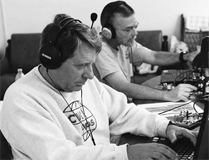HF Noise Monitoring Campaign
 The official RSGB-sponsored part of this project began in June 2013 and has received funds from the RSGB Legacy Committee, endorsed by the RSGB board. The legacy committee is currently managing the generous legacy provided by the late Ken Rowell, G5RL.
The official RSGB-sponsored part of this project began in June 2013 and has received funds from the RSGB Legacy Committee, endorsed by the RSGB board. The legacy committee is currently managing the generous legacy provided by the late Ken Rowell, G5RL.
For the moment 14 stations are actively participating in the HF Noise Monitoring Campaign. Whilst it is not a specific requirement in order to participate, all stations are using the Cross Country Wireless (CCW) Sentinel SDR receiver and CCW Active Aerial (AA). Details of this equipment can be found on the CCW website. Additional information on the original and ongoing campaign can also be found on Gwyn Williams’ G4FKH website.
The Sentinel requires a Windows XP/Windows 2000 operating system PC to run the freely available software associated with this project, also available from the CCW website. The AA is capable of surviving high RF field strengths from HF transmitters operating on the same site. It is also fitted with a transformer balanced coupling to ethernet cable, for excellent common mode rejection. These are just a few advantages of such an aerial system.
It is suggested that the AA be mounted at least 7M away from buildings and as high as practical, 3M seeming reasonable. However, local circumstances may dictate otherwise.
The system as described above takes 500 measurements of the background noise on each of the 5 frequencies every 10 minutes. The frequencies being utilized are; 3.499MHz, 5.258MHz, 6.999MHz, 10.090MHz and 13.399MHz, the measurement bandwidth is 500Hz. The program then calculates 3 pieces of data for each frequency, the highest measurement, the lowest measurement and the median measurement. As long as the controlling PC has an internet connection, the measurements are sent every 10 minutes to the APRS system from where they are picked up by our data controlling server. The data is then displayed as seen on the main page in data table format, graphic format and map format. Also available are two historical tables; (i) seasonal and (ii) monthly. The seasonal output mimics the ITU-R PI.372 output format and so can be used for comparison with that method.
We are still working to improve aspects of this campaign and would greatly appreciate many more participants to assist with this beneficial campaign, which is aimed at assisting all those using the HF spectrum.
Gwyn Williams, G4FKH
Noise Measurement Campaign, Project Manager.
Using this Application
Select the station and band from the drop-down menus. Enter the number of rows of data to fetch—default 100—and whether to scale the chart to the median line or the min/max extent.
Spots on the map are outlined in red if telemetry has been recorded in the last hour and outlined in blue otherwise. The spot for the currently selected station is filled in red.
Software
This software comes in two principal components:
Data Collection
Noise & GPS telemetry is collected from stations on the APRS-IS network. Packets addressed to G4FKH and conforming to an expected format are listened for and stored. GPS telemetry is tallied with the last received noise packet. Data collection is performed in Perl using Ham::APRS::IS and stored using SQLite.
Data Reporting
Reporting is performed using Perl with charting in D3JS and geographic data from Natural Earth.
Credits
- More information and Coordination by Gwyn Williams G4FKH
- Hardware by Chris Moulding G4HYG
- Software by Roger Pettett G7TKI
- Aspects by David Cutter G3UNA
- D3JS
- Ham::APRS::FAP
- Ham::APRS::IS
- Geography










